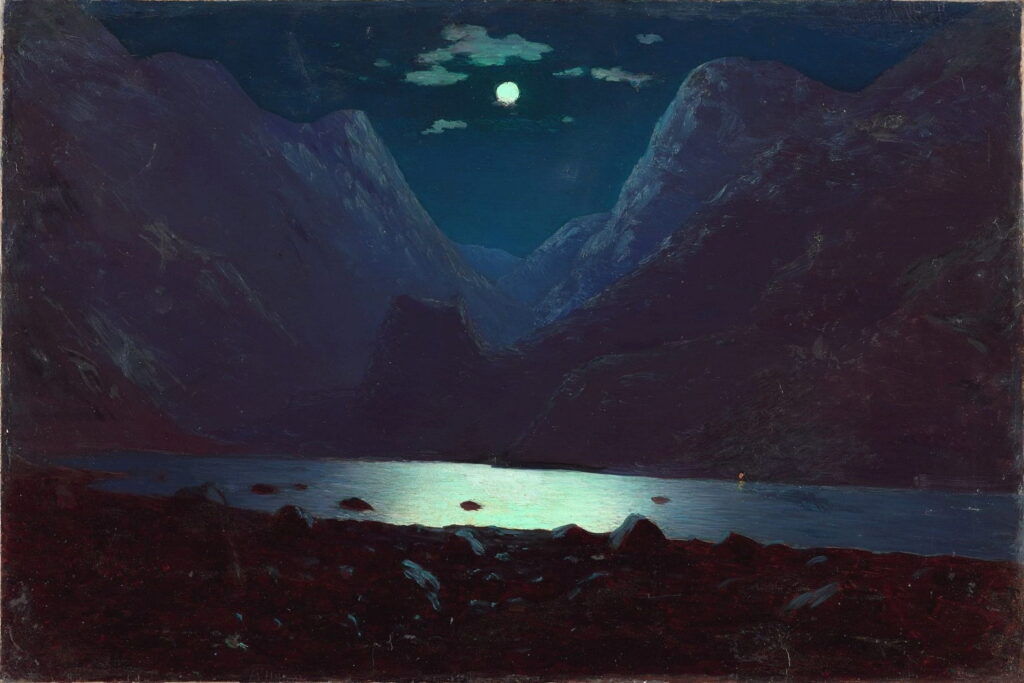Sea of Mists: Influenced, Arkhyp Kuindzhi

The influence of German Romanticism, as expressed in the paintings of Caspar David Friedrich and JC Dahl, extended well beyond the confines of modern Germany. Among those thought to have been influenced is a Pontic Greek painter from Mariupol in the far south-east of Ukraine, Arkhyp Kuindzhi (1841-1910).
After spending some of his youth in the nearby Russian city of Taganrog, when he was fourteen he travelled to Feodosiia in the east of Crimea, to work and study in the studio of the great marine artist Ivan Aivazovsky. Although Kuindzhi received little teaching from the master himself, he was influenced by him, and taught mostly by Adolf Fessler, another of Aivazovsky’s pupils.
In 1860, Kuindzhi moved back to Taganrog to work until he travelled to Saint Petersburg, where he became a student at the Imperial Academy in 1868. There he joined the Wanderers (Peredvizhniki) in 1870, leaving the Academy two years later. He met with early success, selling one of his early paintings to the merchant banker Pavel Tretyakov for his collection in Moscow, and in 1874 was awarded a bronze medal in London. Throughout his career he returned to Ukraine to paint its landscapes.
Arkhyp Kuindzhi (1841–1910), Chumak Road in Mariupol (1875), media and dimensions not known, Tretyakov Gallery Государственная Третьяковская галерея, Moscow, Russia. Wikimedia Commons.
Kuindzhi’s Chumak Road in Mariupol from 1875 shows one of the major activities in this part of the Ukraine at the time, trading using wagons hauled by a pair of oxen. Chumaks had flourished in the seventeenth century, selling and transporting commodities including salt, fish and grain. By the end of the century, competition from the developing railways had put them into decline.
Arkhyp Kuindzhi (1841-1910), After a Thunderstorm (1879), further details not known. Wikimedia Commons.
Following his influence by Aivazovsky, Kuindzhi soon specialised in painting in spectacular light. After a Thunderstorm (1879) is an oil sketch capturing the brilliant colour and light following heavy rain on the steppe.
Arkhyp Kuindzhi (1841-1910), Dnipro in the Morning (1881), oil on canvas, 107.5 x 170.5 cm, Tretyakov Gallery, Moscow, Russia. Wikimedia Commons.
He also fell in love with the great River Dnipro, and painted it in a series of views, among them The Dnipro in the Morning from 1881, showing his fine control of detail and aerial perspective.
Arkhyp Kuindzhi (1841–1910), Moonlit Night on the Dnipro (1882), oil on canvas, 104 x 143 cm, Tretyakov Gallery Государственная Третьяковская галерея, Moscow, Russia. Wikimedia Commons.
It’s this nocturne, Moonlit Night on the Dnipro, here seen in one of his copies from 1882, that Kuindzhi is most famous for, and the strongest evidence for his Romantic influence. Silhouetted against the moonlight reflected from the river is a solitary windmill, and in the foreground are a few cottages.
In 1892, Kuindzhi was appointed a professor at the Imperial Academy, where he taught until being dismissed in 1897 for supporting the protests of students.
Arkhyp Kuindzhi (1841–1910), Midday. Herd on the Steppe (1890-95), oil on paper mounted on canvas, 40 × 49 cm, Russian Museum Государственный Русский музей, Saint Petersburg, Russia. Wikimedia Commons.
Between 1890-95, he painted Midday. Herd on the Steppe, one of his many views with a low horizon and heaped cumulus clouds so typical of summer in this area.
Arkhyp Kuindzhi (1841–1910), Daryal Pass. Moonlit Night (1890-95), oil on paper mounted on cardboard, 38 x 56.5 cm, Tretyakov Gallery Государственная Третьяковская галерея, Moscow, Russia. Wikimedia Commons.
Kuindzhi’s Darial Pass. Moonlit Night, painted following a visit in 1890-95, shows a section of this 13 kilometre (8 miles) long Military Road connecting Russia and Georgia in the tranquil conditions of summer. This gorge runs north-south through the Caucasus Mountains, and has seen extensive use by armies and traders.
Arkhyp Kuindzhi (1841-1910), Landscape in Crimea (1896), oil on canvas, 42.5 x 37.5 cm, Kansallisgalleria, Ateneum, Helsinki, Finland. Wikimedia Commons.
Landscape in Crimea (1896) is a wonderfully loose view of the rocky cliffs beside a rough Black Sea.
Arkhyp Kuindzhi (1841-1910), Red Sunset on the Dnipro (1905), oil on canvas, 134.6 x 188 cm, Metropolitan Museum of Art, New York, NY. Wikimedia Commons.
Red Sunset on the Dnipro (1905) is one of few Ukrainian paintings to have made their way beyond Ukraine and Russia: this is in the Met in New York, and is a fine example of Kuindzhi’s paintings of altered light.
Arkhyp Kuindzhi (1841–1910), Night (1905-08), oil on canvas, 107 x 169 cm, Russian Museum Государственный Русский музей, Saint Petersburg, Russia. Wikimedia Commons.
His Night from 1905-08 shows horses grazing on the bank of a broad river, quite probably the Dnipro, under the light of a crescent moon, again very Romantic.
Arkhyp Kuindzhi (1841–1910), Birch Grove (date not known), further details not known. Wikimedia Commons.
Another of his favourite themes is the Birch Grove, here in one of his many undated oil sketches.
In 1909, Kuindzhi founded the Society of Artists, which was later named in his honour. He died the following year, 1910, in Saint Petersburg.
References
Wikipedia
Andrey Kurkov and others (2022) Treasures of Ukraine, A Nation’s Cultural Heritage, Thames & Hudson. ISBN 978 0 500 02603 8.
Konstantin Akinsha and others (2022) In the Eye of the Storm, Modernism in Ukraine 1900-1930s, Thames & Hudson. ISBN 978 0 500 29715 5.


